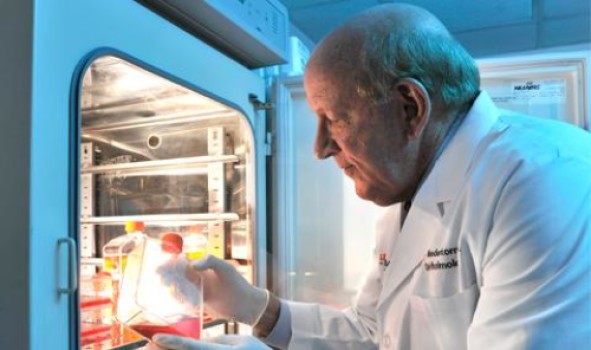
UT Southwestern Medical Center ophthalmologists have identified an important cause of why secondary corneal transplants are rejected at triple the rate of first-time corneal transplants.
The cornea — the most frequently transplanted solid tissue — has a first-time transplantation success rate of about 90 percent. But second corneal transplants undergo a rejection rate three times that of first transplants.
“Understanding why these rejections occur is important to further improving the ways in which corneal transplants are performed,” said the study’s senior author Dr. Jerry Niederkorn, Professor and Vice Chair of Research of Ophthalmology, and Professor of Microbiology. “In the future, ophthalmologists may be able to implement processes, and eventually prescribe medications, that can lower the rates of rejection.”
More than 40,000 transplants are performed annually to replace the cornea, the clear outer lens at the front of the eye, with tissue from a donor. Most corneal transplants are done to correct severe visual impairments caused by keratoconus, a condition in which the normally dome-shaped cornea progressively thins and becomes cone-shaped, according to the American Academy of Ophthalmology.
The high success rate of first-time corneal transplants is attributed to a process called immune privilege, which allows transplants to be successfully performed without matching the donor tissue to that of the recipient, as is required for organ transplants.
Although immune privilege accounts for the initial high success rate, it can occasionally fail, leading to the rejection of corneal transplants in approximately 10 percent of patients. In patients requiring a second transplant, the incidence of immune rejection rises to almost 70 percent.
“We believe that this loss of immune privilege is similar to an alarm that signals the immune system of potential infection, which results in a full blown immune response at the expense of the corneal transplant,” said Dr. Niederkorn, who holds the Royal C. Miller Chair in Age-Related Macular Degeneration Research and the George A. and Nancy P. Shutt Professorship in Medical Science.
Researchers studying mouse models discovered that after the first corneal transplant is accepted, T regulatory cells prevent other types of immune cells from attacking and rejecting the transplant.
But severing corneal nerves, which occurs during the first transplantation procedure, releases high levels of the neuropeptide Substance P. The resulting high Substance P levels disable the T regulatory cells needed for acceptance of subsequent corneal transplants. This inactivation results in rejection of more than 90 percent of the second corneal transplants in mice and helps to explain the curiously high risk for corneal graft rejection in patients who receive a second corneal transplant.
Researchers found that the high Substance P levels can be blocked with drugs to restore the eye’s immune privilege and promote the acceptance of second corneal transplants.
The study, which appears in the American Journal of Transplantation, is supported by grants from the National Institutes of Health and Research to Prevent Blindness.
Future research will focus on pharmacological strategies for restoring T regulatory cell function and promoting the survival of second corneal transplants. Other studies will determine if these findings can be extended to enhancing the immune response to cancer
Story Source:
The above story is based on materials provided by UT Southwestern Medical Center. Note: Materials may be edited for content and length.
Journal Reference:
- K. J. Paunicka, J. Mellon, D. Robertson, M. Petroll, J. R. Brown, J. Y. Niederkorn. Severing Corneal Nerves in One Eye Induces Sympathetic Loss of Immune Privilege and Promotes Rejection of Future Corneal Allografts Placed in Either Eye. American Journal of Transplantation, 2015; DOI: 10.1111/ajt.13240
